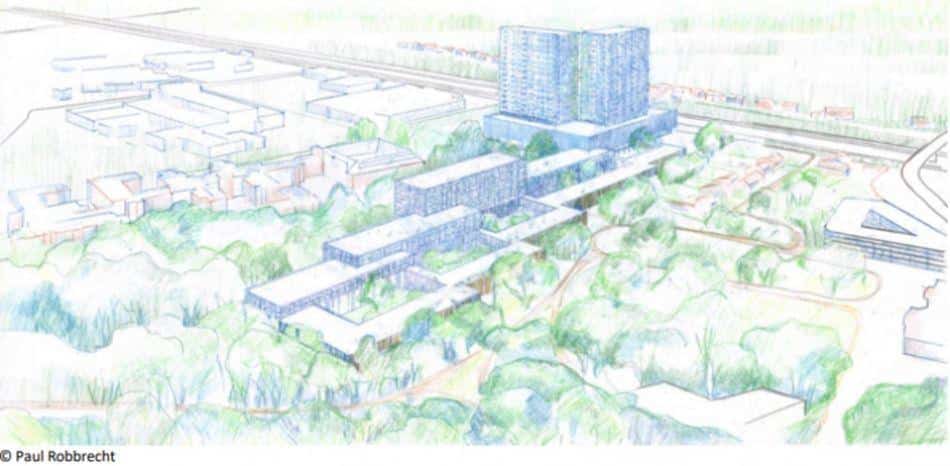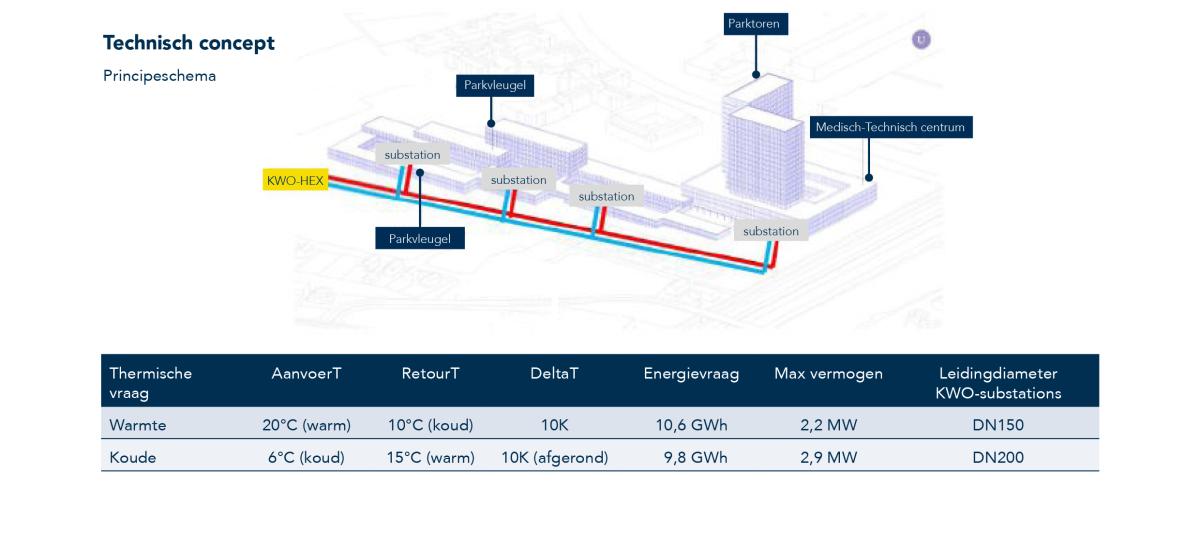Jessa hospital is embarking on a transition to sustainable energy neutrality
The hospital’s goal is to move from 50 % renewable energy in 2031 to fully self-sufficient energy management in 2050 on its future unified campus in Hasselt (Belgium), where three existing care campuses and a logistics campus will be centralised. EnergyVille/VITO was engaged to design the energy system, and concluded that the best solution was a heating and cooling network based on geothermal energy. This is how EnergyVille/VITO is helping healthcare facilities with the transition to sustainable systems.
The Salvator Plus site, where the centralised Jessa Hospital campus will be realised, will be one of the most important construction sites in Hasselt in the next few years. This campus will be called Ons Zorgpark, and will bring together three existing hospitals and a logistics campus that are currently spread over Hasselt and Herk-de-Stad, with a total capacity of nine hundred beds. Various care functions will be combined, including specialist hospital services, an out-of-hours GP practice and a paediatrician for students. Two large wings more than 80-metres high will form the core of the campus, and dominate the Hasselt skyline.
Demolition of the existing buildings on the site will start in 2024. Excavations for the first foundations for the new building are planned for 2025. The opening and major relocation operation is scheduled for 2031. By 2030, we will have already passed an important milestone in the transition to a climate-neutral future in Europe. The interim targets are to reduce the emission of greenhouse gases by 50 % compared to 1990, and ensure that the energy supplied from renewable sources covers around a third of total needs. Ons Zorgpark will meet this latter target easily. ‘When opening, about half the energy we consume will be derived from renewable sources,’ says Karl Zwinnen from Jessa Hospital’s Infrastructure & Master Planning Department. ‘By 2050, our aim is to be completely energy neutral, meaning we’ll generate all the energy we consume ourselves. This generation will be fossil-free, so no gas or heating oil.’

Innovatief geothermal grid
Jessa Hospital’s energy objectives reflect the sustainability transition that the hospital group is undergoing. This transition, which goes beyond the field of energy and includes other areas such as water management (see box), is more difficult than it may seem at first sight. Zwinnen:’ It goes without saying that health is always the priority in our sector, which is why sustainability wasn’t always at the top of the agenda. As a result, hospitals are still lagging behind in this area.’ Hospitals also consume a lot of energy, as is illustrated by the fact that the largest current hospital in the Jessa group accounts for 10 % of Hasselt’s total power consumption. New technology is also responsible for even higher energy consumption. ‘Medical scanners, for example, are improving and their resolution is increasing, but this requires more power. We see the same happening in our labs, where more and more analyses are carried out by robots instead of people. These kinds of innovations therefore often imply higher energy consumption and associated costs.’
Where will Ons Zorgpark get all the energy it needs? Some will come from solar panels that will be installed on both the roofs and walls of the new buildings, but most of the energy needed will be generated by an innovative geothermal network, which will be used for both heating and cooling. This network, which will use the shallow subsurface as both a source and storage area for energy, is the ideal solution. Energy experts from EnergyVille/VITO came to this conclusion following an energy study conducted on behalf of Jessa Hospital.
The sandy subsoil on the Salvator Plus site turned out to be particularly suitable for shallow geothermal energy. ‘It’s possible to generate much more energy than is needed,’ says Gert Moermans of EnergyVille/VITO. For this reason, an additional feasibility study also examined whether the thermal network could be extended to various neighbouring industrial and business parks. This turned out to be technically possible, but not economically feasible. ‘The investments that the owners of the buildings in these areas would have to make are too high. As a result, the network is limited to the Salvator Plus site.’ This may change in the future if it is linked to other thermal networks, such as the Recor site two kilometres away, where a modern business park is currently being built that will also rely on shallow geothermal energy for heating and cooling.
Seasonal energy storage
The energy study was based on the current energy demands of the four existing Jessa campuses. This data and future forecasts were used by the experts from EnergyVille/VITO to calculate the energy needs of the future campus. ‘We took all the relevant factors into account, such as the type of building or department,’ says Thomas Neven of EnergyVille/VITO. For their study, the experts assumed the use of sustainable energy, heat and cold storage and heat pumps. These preconditions determined how much freedom they had in their search for solutions.
One unusual innovation proposed by EnergyVille/VITO in its recommended thermal network is wide-ranging energy exchange. This enables heat released during the permanent cooling of the operating quarters to be used elsewhere, for example. In addition, if the network is unable to immediately dissipate that recovered heat, it can be stored underground in the form of hot water injected into the sandy soil. Neven: ‘This thermal coupling with the subsoil broadens the time window in which energy circulates and is exchanged. We can store excess heat in the summer as seasonal storage, and then use it again in the colder seasons. A geothermal system is ideal for this job.’

The role of EnergyVille/VITO went beyond mere presentation of the results of the study. The energy specialists are also making sure that the design principles are communicated to the architects and engineering office appointed by the client. These can then use the principles in the further planning and construction of the thermal network.
As mentioned, making the healthcare sector more sustainable is quite a challenge. Among other issues, energy renovations have to be carried out while a hospital continues to function, and the security of the energy supply overrides other considerations when planning renovations or new construction. Despite this, more and more hospitals are now opting to increase sustainability, encouraged by high energy bills and initiatives from the Flemish government such as the Green Deal Sustainable Care that kicked off in 2023. ‘Sustainability and health go hand-in-hand,’ says Karl Zwinnen. ‘At the moment, both are of the utmost importance to us, so we’re deeply committed, together with our design team, to ensuring sustainability is respected from the earliest design stages of Ons Zorgpark. This also proves how seriously we take our social responsibility.’
The study work for Jessa Hospital shows that EnergyVille/VITO is the ideal partner for hospitals and healthcare institutions to turn to for tailor-made advice on their sustainability transition.